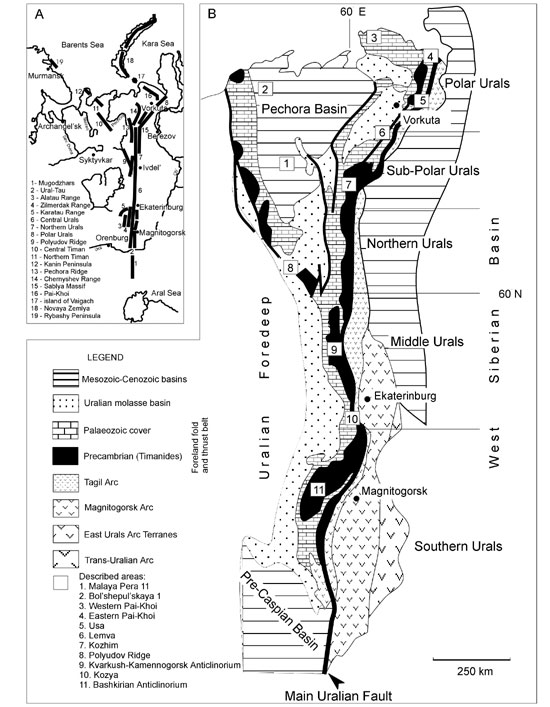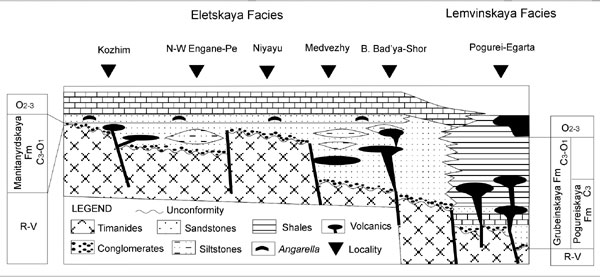
The post–Timanian evolution of the northeastern and eastern margin of Baltica: facies and biogeography –a review
Olga K. Bogolepova1
1 Department of Earth Sciences, Uppsala University, Villavägen 16, SE–752 36, Sweden. E–mail: olga.bogolepova@geo.uu.se / eprobe@geofys.uu.se
Key words: Facies. Biogeography. Timanian. Early Ordovician. Baltica.
A complex Neoproterozoic orogenic belt, known as the Timanide Orogen, can be traced along the northeastern and eastern margin of the East European Craton (Figure 1). The timing of orogeny is constrained to the Vendian, perhaps extending into the Early Cambrian (see Puchkov, 2002, for references). The Lower Palaeozoic sequences, unconformably overlying the Timanides of Timan, Pechora, Pai–Khoi, Vaigach. Novaya Zemlya and the Polar, Northern, Middle and Southern Urals are reviewed with regard to their stratigraphy, sedimentation and biogeography.
During much of Cambrian time, the Timanide area was uplifted and eroded. In general, rocks of the Lower, Middle and lowermost parts of the Upper Cambrian are missing. Beneath the Lower Palaeozoic unconformity there is local evidence of extensive weathering. Locally, in the basement several kilometres beneath the Pechora Basin, red sandstones (Bogatsky et al., 1996) and acid volcanic rocks (Belyakova and Stepanenko, 1991) have been found beneath the Palaeozoic unconformity. Their low grade metamorphism and deformation have suggested that they may represent a hinterland–basin molasse facies, deposited on underlying more altered Timanide complexes. Decisive evidence is lacking.
Sedimentation started in the Ordovician or, particularly in eastern areas along the front of the Urals, in the Late Cambrian. Upper Cambrian and Tremadoc strata were apparently deposited during early rifting of the Baltica margin and a passive margin was established by the Arenig, prior to the opening of the Palaeo–Uralian Ocean. Volcanism occurs throughout the Ordovician and, at least locally, in the Late Cambrian, in general being characterised by alkaline basalts, porphyrites and tuffs. The Early Palaeozoic rifting of northeastern Baltica was discordant to the Timanide Orogen in the Timan – Pechora – Polar Urals region; further south, it apparently controlled the deformation front of the Urals during subsequent Palaeozoic orogeny.
The Upper Cambrian to Ordovician successions throughout most of the area underlain by Timanide basement have a similar facies development, dominated by shallow marine environments; known as the Eletskaya Facies (Voinovsky–Kriger, 1967). Only in the most easterly outcrops in the front of the Urals is a basinal succession of Late Cambrian and Ordovician age represented, dominated by shales and termed the Lemvinskaya Facies (Voinovsky–Kriger, 1967).
The basal beds which unconformably overlying the Timanide units, are composed of siliciclastic, poorly sorted continental and shallow marine deposits. Overlying these basal clastics in the east (Uralian front) is a monotonous Upper Cambrian and/or Tremadocian succession of sandstones, siltstones, limestones and shales. The sandstones and sandy shales are cross–bedded, rippled and they generally lack macrofossils (or the latter have extremely low diversity) and the facies is interpreted to represent coastal marine, shallow water, high energy environments. These occur in Pechora (1 and 2 on Figure 1B), Kozhim (7 on Figure 1B, Figure 2), Usa (5 on Figure 1B, N–W Engane–Pe, Niyay, Medvezhy, B. Bad’ya–Shor on Figure 2), Vaigach (17 on Figure 1A), the western Pai–Khoi (3 on Figure 1B), Novaya Zemlya (18 on Figure 1A), and the Middle Urals (9 and 10 on Figure 1B).

Figure 1. A. The main geographical elements. B. Generalised tectonic map of the Urals and Timan-Pechora Region, showing localities referred to in the text (based on Peive et al., 1977).

Figure 2. Diagramatic lithofacies profile of the Upper Cambrian and Ordovician sediments across the northern Urals (based on Dembovsky et al., 1990, modified).
The Lemvinskaya Facies was developed in somewhat deeper water. The Upper Cambrian – Tremadocian strata of Lemva (6 on Figure 1B) and Pogurei–Egarta in the Polar Urals (Figure 2), the eastern Pai–Khoi (4 on Figure 1A), and the Southern Urals (11 on Figure 1B) are represented by limestones and shales with brachiopods, trilobites, gastropods, conodonts, acritarchs and graptolites. A deepening of the basin from west to east (in modern coordinates) was accompanied by increasing sediment thickness.
These two parallel facial zones, the Eletskaya and Lemvinskaya, are traced along the whole eastern margin of Baltica. The fauna show no evidence of barriers for distribution and migration along this wide, long (2000 km) platform margin. Thus common species such as Alimbella armata, Altorthis kinderlensis, Apatokephalus sp., Medessia uralica and Tritoechia lermontovae occur throughout the Polar (Varganov et al., 1973; Dembovsky et al., 1990), Middle (Antsygin, 1993), Southern Urals (Antsygin, 1993) and Pai–Khoi (Bursky, 1970). The graptolite Rhapdinopora flabelliformis, widely known from the Baltoscandian platform is also found in the Polar (Dembovsky et al., 1988) and Southern (Varganov et al., 1973) Urals. The Cambrian–Ordovician acritarch association (Jankauskas in Belyakova 1988; Varganov et al., 1973) shows a taxomonic similarity with the other parts of Baltica; e.g., the Moscow Syneclise. Some of the taxa are geographically widely distributed. The brachiopod and trilobite faunas listed above are mainly endemic to Baltica, including lycophoriid brachiopods (Lycophoria is known from the Sub–Polar Urals) and asaphid and megistaspid trilobites (e.g., Megistaspis, with ocurrences on Pai–Khoi) or have a wide geographic distribution (Eoorthis, Finkelnburgia, Geragnostus, Irvingella, Lingulella).
Interestingly, Novaya Zemlya (Bondarev, 1964; Bondarev et al., 1973) and the Polar Urals (Dembovsky et al., 1990) show some Laurentian elements in their fossil assemblages (Apheoorthis vicini, Syntrophopsis vetusta, Tritoechia quebecensis), while the Southern Urals (Antsygin, 2001) shares the occurrence of the trilobites Kujandaspis kujandensis with Kazakhstan, and Leimitzia bavarica is known from the Polar Urals, the Southern Urals and Bohemia. The monoplacophoran mollusc Kirengella is found beneath the Pechora Basin (Gubanov and Bogolepova, this volume) and in the Southern Urals (Doguzhaeva, 1972). These shells were described from the southern (the Kirenga River) and northwestern (the Kulyumbe River) parts of the Siberian platform (Rozov 1968), and are also recorded in Laurentia (Stinchcomb and Angeli, 2002). Among the inarticulate brachiopods, Acrothele cf. coriacea, known from Novaya Zemlya (Popov, 1985), has been described before from Scandinavia, while Angulotreta postapicalis – from Laurentia and Estonia. Angarella, widely distributed in the Arenigian–Llanvirnian of Siberia and Taimyr, is typical of the Polar Urals, Pai–Khoi, Novaya Zemlya and the Sub–Polar Urals, but unknown so far from the Middle and Southern Urals. A presence of the deep–water trilobites Nileus and Shumardia in the Pai–Khoi (Bursky 1970) and the Polar Urals (Dembovsky et al., 1990) successions could imply that these areas were located along the edge of the continent in the early Ordovician.
References
Antsygin, N.Ya. 1993. Stratigraphic schemes of the Urals (Precambrian, Palaeozoic). Ekaterinburg, Roscomnedra: 34–46 (in Russian)
Antsygin, N.Ya. 2001. The Tremadocian trilobites of the Urals. Ekaterinburg: 1–247 (in Russian)
Belyakova, L.T. 1988. Stratigraphic units of the Izhma–Omra Complex. In: Bogatsky, V.I. (ed.) Stratigraphy and lithology of the oil and gas deposits of the Timan–Pechora province. VNIIOkeangeologiya, Leningrad: 17–22 (in Russian)
Belyakova, L.I. and Stepanenko, V.Ya. 1991. Magnetism and geodynamics of Baikalides of the Pechora Syneclise. Doklady Akademii nauk SSSR, (geologiya): 106–117 (in Russian)
Bogatsky, V.I., Bogdanov, N.A., Kostyuchenko, S.L., Senin, B.V., Sobolev, S.F., Shipilov, E.V., and Khain, V.E. 1996. In: Bogdanov, N.A. (ed.) Tectonic map of the Barents Sea and the northern part of the European Russia: explanatory notes. Institute of the Lithosphere, Moscow: 1–101 (in Russian)
Bondarev, V.I. 1964. The Pai–Khoi–Novozemel’skaya folded area. In: Bondarev, V.I. (ed.) Tectonics of Europe, Moscow, Nauka, Nedra: 126–128 (in Russian)
Bondarev, V.I., Cherkesova, S.V., Enokyan, S. and Romanovich, B.S. 1973. Geological structures of Novaya Zemlya, Vaigach, Pai–Khoi, Polar Urals and Northern Pechora. In: Pitcher (ed.) Arctic Geology. American Association of Petroleum Geologists Memoir, 19: 301–308
Bursky, A.Z. 1970. Early Ordovician trilobites of the central Pai–Khoi. In: Bondarev, V.I. (ed.) Reference papers on the Ordovician of Pai–Khoi, Vaigach Island and Novaya Zemlya, Leningrad: 96–138 (in Russian)
Dembovsky, B. Ya., Dembovskaya, Z.P., Kluzhina, M.L., Miklyaev, A.S., Nasedkina, V.A., Puchkov, V.M and Tereshko, V.V. 1988. New data on the Upper Proterozoic – Lower Palaeozoic stratigraphy of the western slope of the Northern Urals. Institute of Geology and Geochemistry, Sverdlovsk: 1–62 (in Russian)
Dembovsky, B. Ya, Dembovskaya, Z. P., Kluzhina, M.L. and Nasedkina, V.A. 1990. The Ordovician of the Pre–Polar Urals. Sverdlovsk: 1–196 (in Russian)
Doguzhaeva, L.A. 1972. New Tremadocian monoplacophorans from the southern Urlas. Palaeontological Journal, 1: 24–28 (in Russian)
Gubanov, A.P. and Bogolepova, O.K. Tremadocian Monoplacophoran molluscs from the Pechora Basin of Russia. (This volume).
Popov, L.E. 1985. The Cambrian inarticulate brachiopods from the northwestern part of the Southern Island of the Novaya Zemlya Archipelago. In: Bondarev, V.I. (ed) Stratigraphy and fauna of the Palaeozoic of Novaya Zemlya. Leningrad, Sevmorgeologia: 17–30 (in Russian)
Puchkov, V.N. 2002. Paleozoic Evolution of the East European Continental Margin Involved in the Uralide Orogeny. In: Brown, D., Juhlin, C. and Puchkov, V. (Eds.). Mountain Building in the Uralides. Pangea to Present. AGU Geophysical Monograph, 132, Washington, DC: 9–31.
Rozov, S.N. 1968. The new genus of the Late Cambrian monoplacophoran molluscs (the southern part of the Siberian platform). Doklady Akademii nauk SSSR, 183 (6): 1427–1430 (in Russian)
Stinchcomb, B.L. and Angeli, N.A. 2002. New Cambrian and Lower Ordovician monoplacophorans from the Ozark Uplift, Missouri. Journal of Paleontology, 76 (6): 965–974.
Varganov, V.G., Antsygin, N.Ya. and Nasedkina, V.A. 1973. Stratigraphy and fauna of the Ordovician of the Middle Urals. Moscow, Nedra: 1–228 (in Russian)
Received: February 15, 2003
Accepted: June 15, 2003